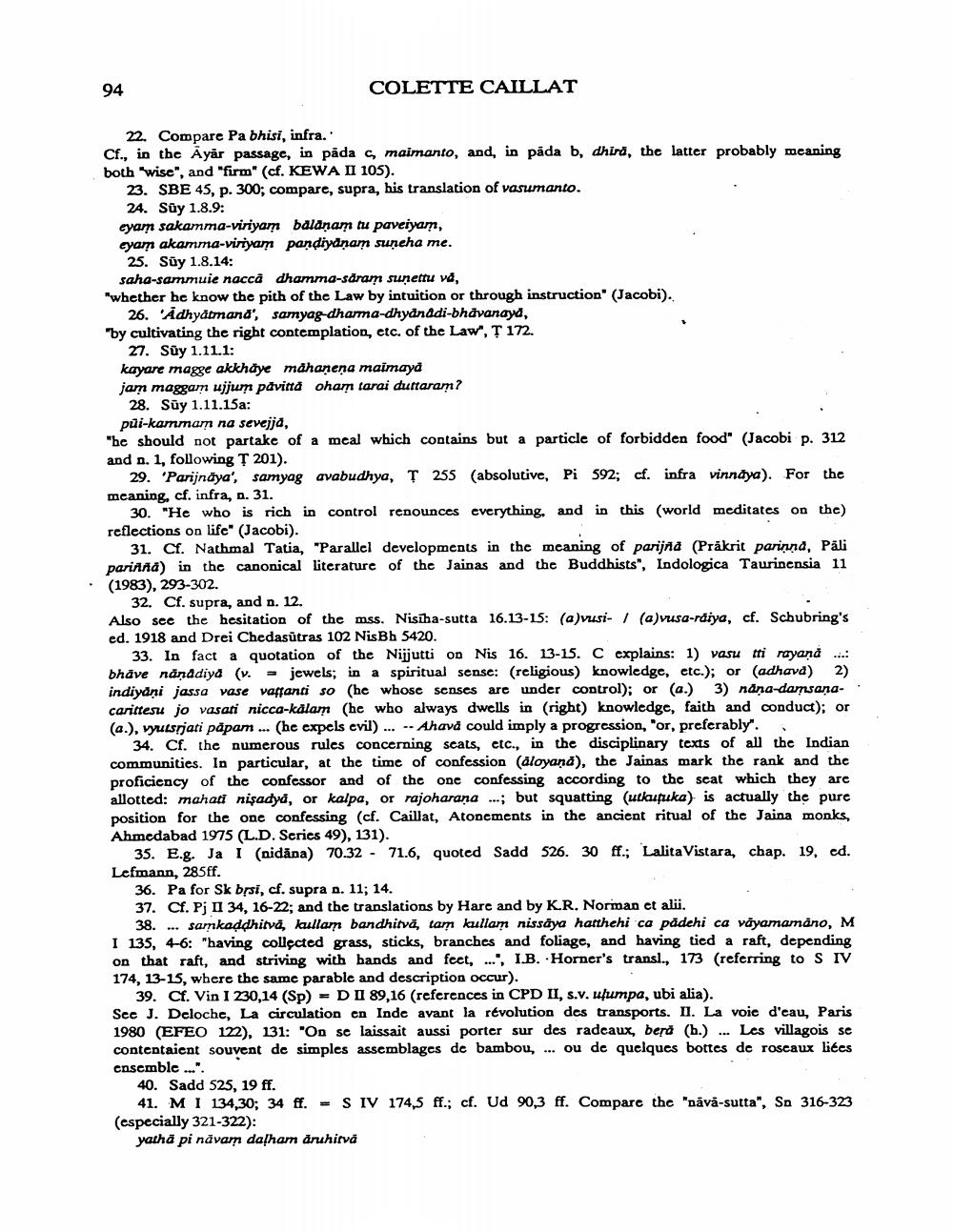________________
94
COLETTE CAILLAT
22. Compare Pa bhisi, infra.' Cf., in the Ayår passage, in pada s, maimanto, and, in pada b, dhird, the latter probably meaning both 'wise", and "firm" (cf. KEWA II 105).
23. SBE 45, p. 300; compare, supra, his translation of vasumanto. 24. Sūy 1.8.9: cyam sakamma-viriyam balanam tu paveiyarn, cyam akamma-viriyam pandiydnamn suneha me.
25. Sūy 1.8.14: saha-sammuie naccă dhamma-säram sunettu va, "whether he know the pith of the Law by intuition or through instruction" (Jacobi).
26. 'Adhyatmand', samyag-dharma-dhydnadi-bhavanayd, "by cultivating the right contemplation, etc. of the Law", T 172.
27. Sùy 1.11.1: kayare magge akkhaye mdhanena maimayd jam maggam ujjurn påvitta oham tarai duttaram?
28. Sūy 1.11.15a: pui-kammam na sevejja, "he should not partake of a meal which contains but a particle of forbidden food" (Jacobi p. 312 and n. 1, following 7 201).
29. 'Parijndya', samyag avabudhya, T 255 (absolutive, Pi 592; cf. infra vinndya). For the meaning, cf. infra, n. 31.
30. "He who is rich in control renounces everything, and in this world meditates on the) reflections on life" (Jacobi).
31. Cf. Nathmal Tatia, "Parallel developments in the meaning of parijna (Prakrit parinna, Pali pariffa) in the canonical literature of the Jainas and the Buddhists", Indologica Taurinensia 11 (1983), 293-302.
32. Cf. supra, and n. 12. Also see the hesitation of the mss. Nisiha-sutta 16.13-15: (a)vusi- / (a)vusa-rdiya, cf. Schubring's ed. 1918 and Drei Chedasútras 102 Nis Bh 5420.
33. In fact a quotation of the Nijutti on Nis 16. 13-15. C explains: 1) vasu ti rayana ...: bhave nånadiya (v. - jewels; in a spiritual sense: (religious) knowledge, etc.); or (adhavd) 2) indiyani jassa vase vaffanti so (he whose senses are under control); or (a.) 3) nåņa-damsana. carittesu jo vasati nicca-kalam (he who always dwells in (right) knowledge, faith and conduct); or (a.), vyutsrjati papam ... (he expels evil)... -- Ahava could imply a progression, "or, preferably".
34. Cf. the numerous rules concerning seats, etc., in the disciplinary texts of all the Indian communities. In particular, at the time of confession (aloyana), the Jainas mark the rank and the proficiency of the confessor and of the one confessing according to the scat which they are allotted: mahati nişadyd, or kalpa, or rajoharana ...; but squatting (utkufuka) is actually the pure position for the one confessing (cf. Caillat, Atonements in the ancient ritual of the Jaina monks, Ahmedabad 1975 (L.D. Scries 49), 131).
35. E.g. Ja I (aidāna) 70.32 - 71.6, quoted Sadd 526. 30 ff.; Lalita Vistara, chap. 19, ed. Lefmann, 285ff.
36. Pa for Sk brsi, cf. supra n. 11; 14. 37. Cf. Pj II 34, 16-22; and the translations by Hare and by K.R. Norman et alii.
38. ... Samkaddhitva, kullam bandhitvā, tam kullam nissaya hatthehi ca pådehi ca vayamamano, M I 135, 4-6: "having collected grass, sticks, branches and foliage, and having tied a raft, depending on that raft, and striving with hands and feet, ..., I.B. Horner's transl., 173 (referring to S IV 174, 13-15, where the same parable and description occur).
39. Cf. Vin I 230,14 (Sp) = D II 89,16 (references in CPD II, s.v. ufumpa, ubi alia). See J. Deloche, La circulation en Inde avant la révolution des transports. II. La voic d'eau, Paris 1980 (EFEO 122), 131: "On se laissait aussi porter sur des radcaux, bera (h.) ... Les villagois se contentaient souvent de simples assemblages de bambou, ... ou de quelques bottes de roscaux liées ensemble ...
40. Sadd 525, 19 ff.
41. M I 134,30; 34 ff. - S IV 174,5 ff.; cf. Ud 90,3 ff. Compare the "nava-sutta", Sa 316-323 (especially 321-322):
yatha pi nävarn dasham anhirva




